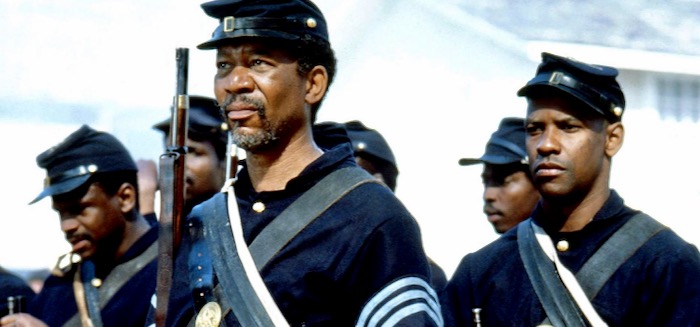
GLORY, the 1989 Oscar-winning Civil War drama starring Morgan Freeman and Denzel Washington, was featured in the first issue of Ed McNulty’s Visual Parables when his faith-and-film journal began in 1990.
.
.
EDITOR’s NOTE: This week, we are celebrating Edward McNulty’s 30th anniversary of his Visual Parables Journal by publishing Ed’s personal reflections on his decades of moving between movie theaters, his role as an online journalist and his ongoing work with congregations and conferences. Here’s a tip: Have a pen and paper handy as you read his column because you’ll want to note some of the wonderfully thought-provoking films Ed mentions. After reading his column, you’ll have a couple of months worth of spirited viewing ahead of you!
But first—before you read Ed’s column, below—all of us who are part of the ReadTheSpirit team want to wish Ed another 30 years in his unique role as America’s guide to spiritual themes in cinema!
Here’s our part of the Visual Parables story: In 2013, ReadTheSpirit magazine merged with Edward McNulty’s longstanding Visual Parables Journal so that we could bring his many decades of faith-and-film writing into our community of columnists and authors.
In addition to moving his huge online database of faith-and-film reviews into ReadTheSpirit online magazine, we collaborated with Ed in producing the book Jesus Christ Movie Star, which we describe this way: “Pop some popcorn and invite friends as America’s beloved faith-and-film writer Edward McNulty leads us through a dozen big-screen stories inspired by Jesus’s life.” This week’s Front Edge Publishing column tells much more about this book.
Then, in every weekly issue of ReadTheSpirit we include our popular Faith
& Film section that features Ed’s free-to-read reviews—as well as newsy updates about the Visual Parables Journal. Here’s how we explain that to readers each week:
ED McNULTY, for decades, has published reviews, magazine articles and books exploring connections between faith and film. Most of his work is freely published. Ed supports his work by selling the Visual Parables Journal, a monthly magazine packed with discussion guides to films. This resource is used coast-to-coast by individuals who love the movies and by educators, clergy and small-group leaders. And, right now you can check out the new February 2020 issue.
.
AND, NOW …
HEEEEEERE’S ED …
.
By ED McNULTY
Writer and Editor of Visual Parables Journal
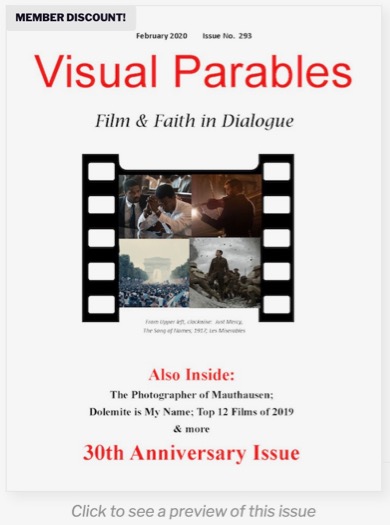 It was 30 years ago this month that Visual Parables was launched as a two-page, paper newsletter—so it’s time to reflect on its history and the changes that have taken place in films and the way we consume them.
It was 30 years ago this month that Visual Parables was launched as a two-page, paper newsletter—so it’s time to reflect on its history and the changes that have taken place in films and the way we consume them.
I estimate that I have seen almost 6,000 movies during these 3 decades. There have been some terrific films that I have written about in the pages of Visual Parables that I want to recommend to you, as you read this story. These spirited movies still are well worth watching—so there’s a bonus in reading my anniversary story: You may wind up with a fresh list of must-see movies.
In February 1990, I was serving a Presbyterian church in Dayton, Ohio, where I also was very involved in the community as a film advocate. I led a group of churches that sponsored an annual film series at a downtown theater during Lent that drew enthusiastic crowds on the six Sunday afternoons before Easter. I had just seen four excellent films and was eager to share news of them with others, but there were few options for sharing such columns.
I decided to launch a newsletter using the $50 received for a speaking engagement (about film and theology, of course). This was the two-page newsletter Visual Parables, named after my workshops in which I showed audiences that certain films were like the parables told by Jesus. Because I was the chair of its Media Committee, the Presbytery of Miami Valley allowed me to use its mailing list of a few hundred ministers and church leaders.
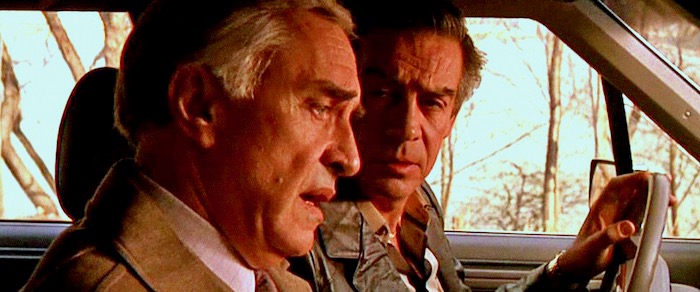
CRIMES AND MISDEMEANORS, Woody Allen’s 1989 tragicomedy starring Martin Landau, also was featured in Visual Parables’ first issue—and remains one of Ed’s favorites in sparking group discussions.
A NEW JOURNAL FOR THOUGHTFUL MOVIE LOVERS
The films in that first issue were Driving Miss Daisy; Glory; Born on the 4th of July; and Crimes and Misdemeanors. None of these were religious films, but I believed that all had themes and insights that religious folk could relate to and should be discussing. I had a long history of using films in church educational programs, as well as writing film reviews for numerous magazines and newspapers—secular, Roman Catholic and Protestant. I also had authored several books on media.
Of those four films in the first issue, Woody Allen’s tragicomedy Crimes and Misdemeanors is the film I keep going back to when dealing with the ways of God and recalcitrant humanity. A theology professor at United Theological Seminary annually borrowed my copy of the film to show to his class when he dealt with theodicy. The story reverses the usual order: In Allen’s film, the bad guy gets the girl and the adulterer gets away with the murder of his pesky mistress about to talk with his wife. Running through this story is wisdom from Proverbs 15:3, “The eyes of the Lord are in every place, keeping watch on the evil and the good.” Indeed, “eyes” are important symbols in the film, the bad guy being an ophthalmologist whose patient is a rabbi going blind. The film and its un-Hollywood ending leaves us discussing who in the film really “sees” and who is really blind. Made when the filmmaker was at the height of his creative powers, the film challenges facile assumptions about God and morality in as funny and a dramatic way as few others have.
The newsletter’s reception was positive—and some readers were willing to pay the princely sum of $12 for an annual subscription. Thus I expanded to a four-page newsletter, and soon began inserting each month a 2-page discussion guide for an especially rich film.
There were so many rich films!
Just to list a few, in 1990 there was Barry Levinson’s intergenerational Avalon focusing on the relationship between a young boy and his grandfather; a rare story about the cruel WW 2 round-up of Japanese citizens, Come See the Paradise; and the still under appreciated little master piece The Long Walk Home, starring Whoopi Goldberg and Sissy Spacek, the former playing a “colored” maid who had to walk across town to her job as a maid and cook in a white household during the Montgomery Bus Boycott. (NOTE: All of those links will take you into the free-to-read database of movie reviews in our Visual Parables section of ReadTheSpirit.)
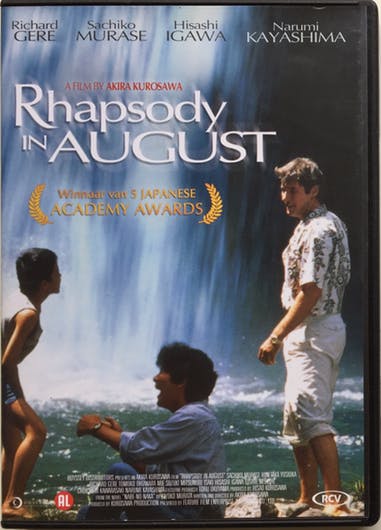 In 1991, young John Singleton startled the film world with his unblinking look at teenagers trapped by racism in the ghetto, Boyz n the Hood. Also there was Lawrence and Meg Kasden’s great take on urban malaise of both blacks and whites, Grand Canyon; in Rhapsody in August, Japanese director Akira Kurosawa transported us to Nagasaki where a family whose grandmother was widowed by the atom bomb anxiously wonder how she will receive the visit of a distant relative from America; and one of my favorite movies, The Fisher King, artfully combined the medieval myth of the Fisher King, the Quest for the Holy Grail, and even a bit of Pinocchio and the Genesis story of Jacob the Grabber. I have lost count of how many times I have used scenes from that Terry Gilliam film in Visual Parables articles and workshops. It remains my favorite Robert Williams film. Same goes for his co-star, Jeff Bridges.
In 1991, young John Singleton startled the film world with his unblinking look at teenagers trapped by racism in the ghetto, Boyz n the Hood. Also there was Lawrence and Meg Kasden’s great take on urban malaise of both blacks and whites, Grand Canyon; in Rhapsody in August, Japanese director Akira Kurosawa transported us to Nagasaki where a family whose grandmother was widowed by the atom bomb anxiously wonder how she will receive the visit of a distant relative from America; and one of my favorite movies, The Fisher King, artfully combined the medieval myth of the Fisher King, the Quest for the Holy Grail, and even a bit of Pinocchio and the Genesis story of Jacob the Grabber. I have lost count of how many times I have used scenes from that Terry Gilliam film in Visual Parables articles and workshops. It remains my favorite Robert Williams film. Same goes for his co-star, Jeff Bridges.
1992 was a good year too, with the then little-known story of the WW2 opportunity for women to play professional baseball, A League of Their Own; a true story of a mother’s love and frantic search for a cure for her ill son, Lorenzo’s Oil; another true story of the little understood black leader feared by whites, Malcolm X; and the sadly forgotten Love Field, taking its title from the Texas airport where the Kennedy’s landed on that fateful November day in 1963.
Connecting the Spiritual Message to Scripture
The purpose of the newsletter grew from merely reviewing new films deemed worthy—lots of religious publications were already doing that—to suggesting ways that a leader could use the film to explore the gospel and ethical issues. I spent considerable time seeking Scripture passages that related to themes in the film. I think that my citing so many passages from the Hebrew Scriptures—especially Ecclesiastes, Proverbs and Psalms—was the reason that I have welcomed Jewish readers, as well, over the years.
I agreed with such writers as G. William Jones that people of faith should enter into a “dialogue with the movies.” I was encouraged when numerous folk told me that they now were looking at movies in a new way, that they saw them as more than just entertainment. A number of them were calling or sending notes asking if I had a film discussion guide on a particular movie or theme.
The newsletter’s readership slowly expanded across the country and Canada, and in April 1993 Don Bosco Multimedia, run by a Roman Catholic order, took on its publishing and distribution. They also turned it into a digest-size magazine. In the January 1994 issue, I succumbed to the critic’s year-end desire of making a Top Ten List of films.
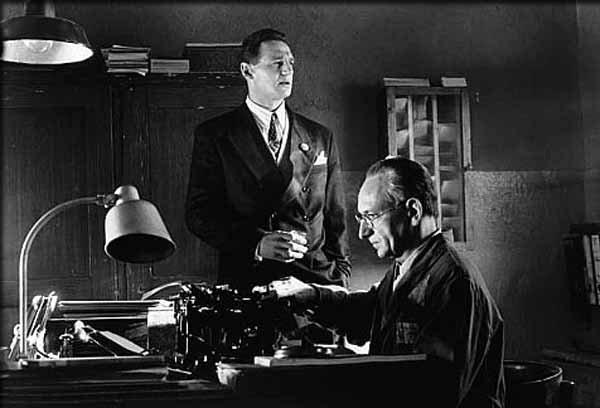 At the top of the 1993 list was A Bronx Tale, brilliantly written by Chazz Palminteri and starring Robert De Niro as a bus driver trying to keep his teenaged son from being influenced by a charismatic local gangster.
At the top of the 1993 list was A Bronx Tale, brilliantly written by Chazz Palminteri and starring Robert De Niro as a bus driver trying to keep his teenaged son from being influenced by a charismatic local gangster.
Stephen Spielberg’s Holocaust film Schindler’s List did not open in Dayton until early 1994, but it dominated the March 1994 issue with a review of both the movie and book and what I think is one my two best discussion guides. Organized around Psalm 22 “My God, my God, why have you forsaken me?” it is divided into 3 parts, “The Hell of Foresakeness,” “The Hope for Deliverance,” and “Remembering and Giving Thanks.”
Another film that I think influenced society was Philadelphia in which Tom Hanks plays a lawyer dying of AIDs and Denzel Washington is his prejudiced lawyer who takes up his suit against his former employers for unlawful job termination. At a college workshop, a young women raised in a Fundamentalist church told me “This is the film that made me realize my church was wrong.”
Other notable 1994 reviews included the Disney-animated The Lion King; Ang Lee’s Eat, Drink, Man, Woman; Quinten Tarantino’s incredible Pulp Fiction, which surprised me with its theology of grace! Also Priest dealt sympathetically with the gay issue in the Roman Catholic Church; and the little-known Kevin Costner film The War presented a powerful demonstration of what Gandhi and MLK meant by nonviolence. Director Robert Redford gave us a great parable on Temptation and Fall in the fact-based Quiz Show. And what a delightful parable of hope Shawshank Redemption turned out to be!
Up in ‘Smoke’
 When Don Bosco decided to drop out of the publishing business in March 1995, I took on the tasks of formatting, printing, and distributing the magazine, in addition to writing most of the material. 1995 saw the release of another of my favorite films, one dealing with spiritual discernment and the changing meaning of a bag of money, Smoke, set in of all places, a Brooklyn tobacco shop. The suggestion was made to preachers that during their church’s stewardship campaigns this film could be used to show how money changes meaning as it changes hands. Another great film of 1995 was the grace-filled prison film Dead Man Walking, with a Catholic nun serving as a Hound of Heaven in bringing a condemned racist-murderer to accept responsibility for his deeds.
When Don Bosco decided to drop out of the publishing business in March 1995, I took on the tasks of formatting, printing, and distributing the magazine, in addition to writing most of the material. 1995 saw the release of another of my favorite films, one dealing with spiritual discernment and the changing meaning of a bag of money, Smoke, set in of all places, a Brooklyn tobacco shop. The suggestion was made to preachers that during their church’s stewardship campaigns this film could be used to show how money changes meaning as it changes hands. Another great film of 1995 was the grace-filled prison film Dead Man Walking, with a Catholic nun serving as a Hound of Heaven in bringing a condemned racist-murderer to accept responsibility for his deeds.
Just as Don Bosco stopped publishing, I moved from Dayton to become the pastor of a small congregation in the picturesque Catskill Mountains of New York. Bovina Center was 30 miles of winding road from the closest theater complex, but because the closer theater did not show many of the independent films so beloved by VP’s readers, I found myself several times a month making the almost two-hour drive to Albany with its larger theater complexes and art house theater.
A Babe-themed Vacation Bible School
 1995’s Babe turned out to be more than a children’s film about a little pig, but a parable of compassion and understanding. The next summer, the children of Bovina were treated to a Vacation Bible School using Babe to explore how God and Christ lead us across foreboding boundaries toward understanding and compassion. I also used it in a church-officer workshop to demonstrate two forms of leadership style, one of top-down demanding, and the other of eliciting cooperation.
1995’s Babe turned out to be more than a children’s film about a little pig, but a parable of compassion and understanding. The next summer, the children of Bovina were treated to a Vacation Bible School using Babe to explore how God and Christ lead us across foreboding boundaries toward understanding and compassion. I also used it in a church-officer workshop to demonstrate two forms of leadership style, one of top-down demanding, and the other of eliciting cooperation.
Shortly after this move, a friend suggested that because so many preachers used the Common Lectionary, Visual Parables might suggest films suitable for the lessons. Thus began, in the June 1995 issue, what became Lectionary Links. This first column included just one Sunday, Pentecost, with a paragraph on the unity of a group of striking coal miners in John Sayles’ great social justice film Matewan. The coverage expanded to three Sundays in the next two issues, and then to all the Sunday texts of the month—well not all, usually the Gospel text being the focus. A number of readers informed me that Lectionary Links was the first section they turned to and read when they received the journal.
In November, 1996, the first of the series “Praying the Movies” appeared, inspired by the video of the 1935 version of Les Misérables. Although similar to the monthly discussion guide in that it had some questions for reflection, Praying the Movies was meant to be a devotional, and so it consisted of several Scripture passages, an introduction, a descriptive meditation based on a film scene and where to find it on the VHS tape, a few questions for further thought, and a closing prayer. Later a relevant hymn was included. These became so popular that Westminster John Knox Press published two volumes of them. Here’s the Amazon link to the first one, Praying the Movies, and here’s a link to the second volume.
Some of the fine films in 1996 included the delightful Fargo; the female Christ Figure tale set in a small town café, The Spitfire Grill; the belated bringing to justice the murderer of Medgar Evers, Ghosts of Mississippi; Ponette, French film about the poignant quest of a little grieving girl for God to let her see her deceased mother; and a bittersweet story of a friendship between a mentally challenged man and a boy.
February 1997 marked the beginning of publication by Viaticum Press, founded by Presbyterian minister Robin Kash. Films of 1997 included Robert Duvall’s masterful story of grace about a preacher on the run for murdering the man carrying on affair with his wife, The Apostle; Stephen Spielberg again tackled a weighty theme in Amistad, the story of the defense of African captives who had killed and taken over their slave ship.
1998 was an even greater year for films, with Spielberg showing us the horrible price of war as we had never seen it depicted, his WW2 Saving Private Ryan making every American appreciate all the more “The Greatest Generation.” Italian director Roberto Benigni dared to use comedy in his Holocaust film about a father’s total devotion to shield his son from its horror, Life is Beautiful; and independent filmmaker John Sayles wrote his film parable, Men With Guns, in Spanish, revealing how hapless Central American peasants are beset by murderous guerrillas on one side and equally brutal soldiers on the other!
Biblical Themes in ‘American Beauty’ and ‘Bringing Out the Dead’
Visual Parable’s July 1999 cover boasted a full-color picture of Liam Neeson starring in Star Wars: the Phantom Menace. That year there were a number of films with easy-to-see biblical themes, such as American Beauty (spiritual discernment); Martin Scorcese’s Bringing Out the Dead, with Nicholas Cage’s medic a good stand-in for Christ: a prison film The Green Mile focusing on an African American gentle giant of a convict with healing powers; and the incredible Magnolia including a scene kin to the Exodus plague of frogs as the stories of hurting people, longing for connection, unfold.
In the January 2000 issue, United Methodist minister Doug Sweet’s column about movie-related resources was introduced. Earlier, Doug and I had met at a national workshop he was leading, and we struck up a friendship that led to his volunteering to contribute a column. He has faithfully written it ever since because of his love for sharing cinematic resources, and, other than thanks, he has never received any remuneration. By subscribing to so many publications and tracking down film books Doug has greatly enhanced the usefulness of Visual Parables.
Top Ten Films for 2000 ranged from the Coen brothers funny tribute to Homer’s Odyssey, O Brother, Where Art Thou to the coming together of whites and blacks around its newly integrated football in a racially troubled Virginia suburb, Remember the Titans.
The June 2002 issue was the last one published by Robin Kash. The magazine had not risen enough in circulation, and he had accepted a position as interim pastor at a large church that left him no time to tend to the chores of formatting and distributing the journal. During its time of stewardship of Visual Parables, Viaticum also published my book Films and Faith: Forty Discussion Guides, filled with almost a year’s material if a film group were meeting on a weekly basis.
It was providential that I had been contributing exegetical materials to the journal LectionAid, because its editor/publisher J. Nicholas Adams came to my aid by putting me in touch with his printer and the technology (Adobe PageMaker) to format the magazine electronically. (During the intervals between publishers earlier I had used the scissors and paste method for formatting an issue.) This change to a new publisher now meant no more color covers and the adoption of a larger 8 ½” x 11” format, both due to printing costs. Also, inside there would be fewer pictures for the same reason. Those printing and distribution costs continued to rise until we resorted to publishing VP for a while on a bi-monthly, and then on a quarterly basis for a couple of years.
Into the New Millennium
In the new millennium, Visual Parables Top Ten lists included such significant films as Lord of the Rings and Shrek (both in 2001); About Schmidt and The Pianist (2002); in 2003 the second of the Lord of the Rings trilogy, and a small independent film about an even “smaller” hero, Station Agent, about which several readers have sent their thanks for bringing this overlooked gem to their attention.
 In 2004 bad boy Mel Gibson’s incredibly bloody The Passion of Christ grossed out some of the faithful and drew others by droves into theaters. Talk (or sing) about “washed in the blood”! C.S. Lewis fans were relieved in 2005 when Disney did not remove the references to Christ in Chronicles of Narnia, and in Munich Stephen Spielberg subtly linked the endless cycle of violence among Arabs and Jews to the Twin Tower tragedy.
In 2004 bad boy Mel Gibson’s incredibly bloody The Passion of Christ grossed out some of the faithful and drew others by droves into theaters. Talk (or sing) about “washed in the blood”! C.S. Lewis fans were relieved in 2005 when Disney did not remove the references to Christ in Chronicles of Narnia, and in Munich Stephen Spielberg subtly linked the endless cycle of violence among Arabs and Jews to the Twin Tower tragedy.
In 2006 Clint Eastwood rose to new artistic heights with the release of his twin films Flags of our Fathers and Letters From Iwo Jima, honoring soldiers of both sides in WW 2.
The Fall 2006 VP marked still another major milestone: It was the last print issue. The combined costs of printing and distribution that had afflicted so many mass media publications took its toll on Visual Parables as well. But, thanks to Nicholas Adams’ technical expertise VP survived by becoming an online publication, with an annual “Best of VP” printed and sent out to subscribers. The good news of this change was that reviews could be posted and read far more quickly on the website. We adopted the policy of posting the reviews on a free basis and the review with discussion questions in the journal available only to subscribers.
A new feature was added to the site, “Film Capsules,” very short reviews designed for use by readers in the newsletters or bulletins of their organizations.
A Great Year: ‘Amazing Grace’ and ‘Lars and the Real Girl’
2007 was an especially great year for films, with such movies as Amazing Grace telling the story of William Wilberforce’s long battle to outlaw the slave trade in England. I almost skipped Lars and the Real Girl because it involved a life-size sex doll, but when readers convinced me to see it, discovered that it was a sweet film with a positive view of a church that truly practiced Christ’s mandate to love the outsider. The next year gave us the delightful animated science fiction film Wall-E about a robot cleaning up a polluted Earth that humans had abandoned. There was also a moving tribute to gay politician Harvey Milk—Milk—and Changeling, an exciting story of how a Presbyterian minister in 1920s Los Angeles came to the aid of a grieving mother being abused by a ruthless L.A. cop following the kidnapping of her son.
In 2010 I was especially moved by the French film Of Gods and Men, based on a true story of a group of monks ministering to villagers in Algeria during the civil war there. Refusing to abandon the villagers, they were martyred by terrorists. In 2011 Trence Malick’s spiritual odyssey Tree of Life led the Top Ten list, and in 2012, the adaptation of Victor Hugo’s novel of grace versus law, Les Miserables. The following year it was the adaptation of 19th century black abolitionist Solomon Northup’s memoir 12 Years a Slave. By incorporating into the study guide a number of awful passages from a book that appeared in the same year—1863—as Northup’s, Bible Defence of Slavery, I believe my review/guide for this was one of my best, equaled only by the one for Schindler’s List.
The Move to ReadTheSpirit
The free access to reviews was continued when Visual Parables moved to ReadtheSpirit.com online magazine.
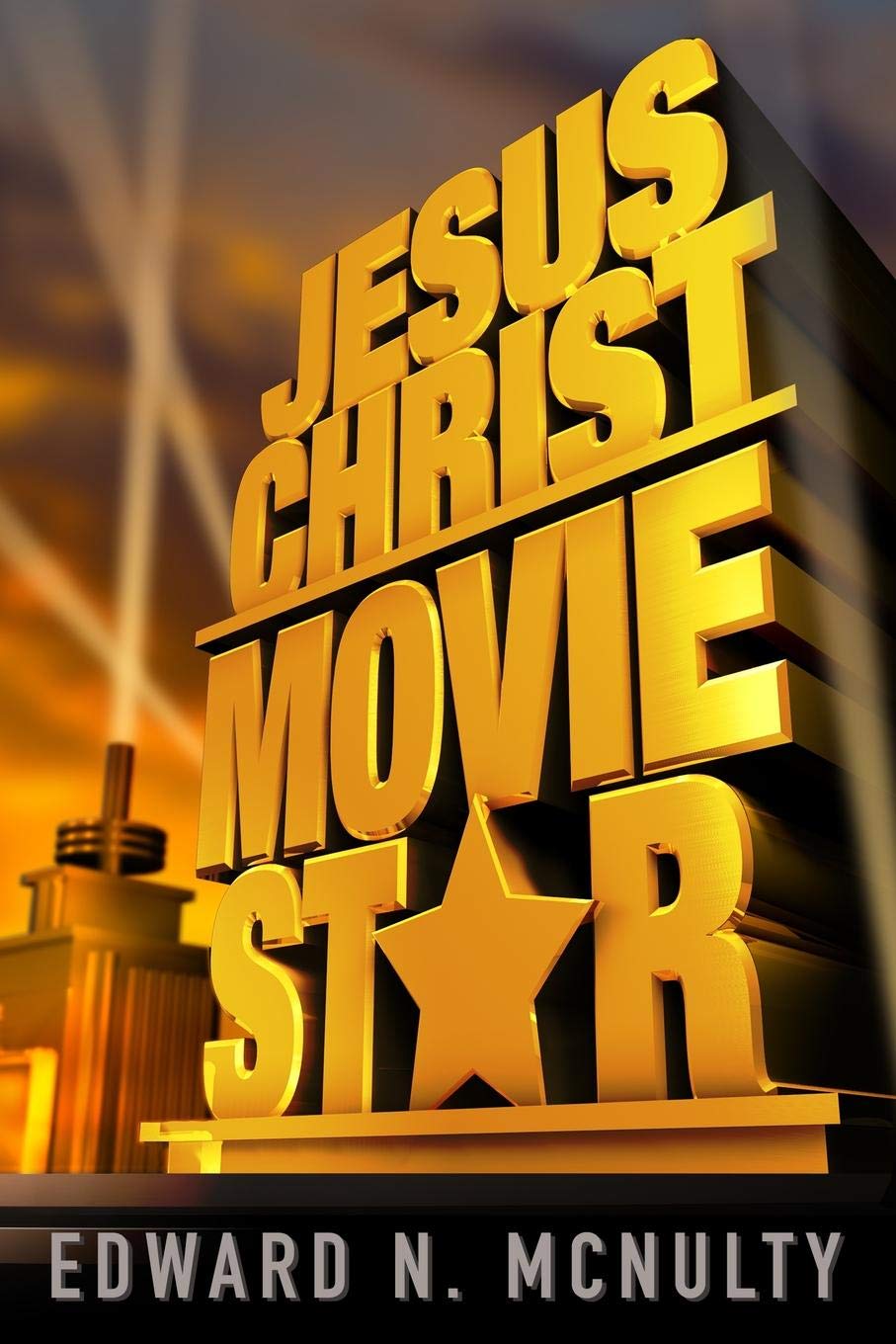 A major advantage of this change was that I was taught how to post a review, eliminating the sometimes long interlude between my writing a review and my old publisher finding the time to post it. My association with this interfaith publisher also led to another book, Jesus Christ: MOVIE STAR, as well as a greater exposure of the reviews to an interfaith readership.
A major advantage of this change was that I was taught how to post a review, eliminating the sometimes long interlude between my writing a review and my old publisher finding the time to post it. My association with this interfaith publisher also led to another book, Jesus Christ: MOVIE STAR, as well as a greater exposure of the reviews to an interfaith readership.
Through the years as the journal has gone through various transformations and publishers, other writers have also contributed their services gratis. Emily Schlaman Larsen reviewed a great number of short films, as has her husband Eric, who also occasionally reviewed an adventure film. These two have also helped greatly to promote the magazine, for which I am grateful.
Markus Watson, the staunchest Star Wars fan that I know, has also covered adventure films that I did not have the time to see. He has moved on to create and host an excellent podcast consisting of interviews with church leaders on the cusp of change entitled Spiritual Life and Leadership.
Pastor Charles Robertson began and contributed to our occasional series “Preaching the Movies.” He is gifted with the ability to weave a powerful film throughout a sermon.
These and a few others have considerably enriched the journal, and I thank them now.
Discovering Unknown Movies: ‘Walking Across Egypt’
“Through the years” also reminds me that here have been just as many, and far more consequential, changes in film and filmmaking as in Visual Parables. In 1990, 16mm film was on the way out for church use, replaced by VHS, which itself a few years later was made obsolete (though not killed off) by DVD. Many thought this too would give way to Blu-ray, but, perhaps because of people like me who have so much invested in DVDs, it has proven hardier than expected.
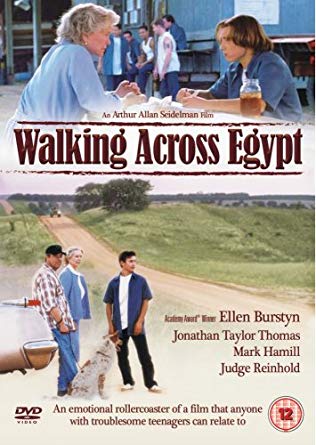 I have been sorry to see video stores fall by the wayside because of having been able to buy so many used DVDs at such great prices. I also used to love discovering movies in the endless racks of DVDs. That’s how I spotted Walking Across Egypt, the story of an old church lady (played by Ellen Burstyn, which is why I bought it without knowing anything of the film) who learns one is never too old to serve God. It’s the best film for use whenever one is dealing with the Parable of the Judging of Nations in Matthew 25.
I have been sorry to see video stores fall by the wayside because of having been able to buy so many used DVDs at such great prices. I also used to love discovering movies in the endless racks of DVDs. That’s how I spotted Walking Across Egypt, the story of an old church lady (played by Ellen Burstyn, which is why I bought it without knowing anything of the film) who learns one is never too old to serve God. It’s the best film for use whenever one is dealing with the Parable of the Judging of Nations in Matthew 25.
Two films from overseas topped VP’s annual list in 2014, a film about an Irish priest who almost literally walks the way of the cross in Calvary because an unknown angry man lumps him with the child molester priests, and Ida, the successful Polish Oscar entry about nuns during the Nazi occupation.
As with Calvary, VP’s top film for 2015, Spotlight, dealt with sex abuse by Catholic priests, this film focusing on the staff of the Boston Globe seeking to expose the cover-up by the diocese. Silence (2016), Martin Scorsese’s theological story of the martyrdom of Jesuit priests in 17th century Japan raises again the question of where is God in the midst of human suffering, as does Paul Schrader’s great story, First Reformed (2018), about a Protestant minister close to losing his faith in the midst of environmental ruin of the land near his church.
In between these years was the first streaming film to make VP’s list, Mudbound, Netflix’s powerful film about racism that effects 2 families in 1940s Mississippi.
It has been a fascinating journey, sometimes bringing me into contact via phone or in person with filmmakers, such as Robert Duvall, Ed Asner, Cliff Robertson, Mike Rhodes, Ken Wales, Cristobal Krusen—skilled artists with the camera who make me understand and love film all the more.
I don’t know how many more years I have to enjoy sharing my love of film and the gospel, but as long as I am able, I hope you will come along for the ride. I love seeing and writing about such films as this year’s top film, Harriet, calling us to value freedom enough to fight for it, as Harriet Tubman did so effectively during the even darker days of the mid-19th century. The ride may not always be smooth, but it will be interesting, and sometimes in response to a movie like Just Mercy—exhilarating.

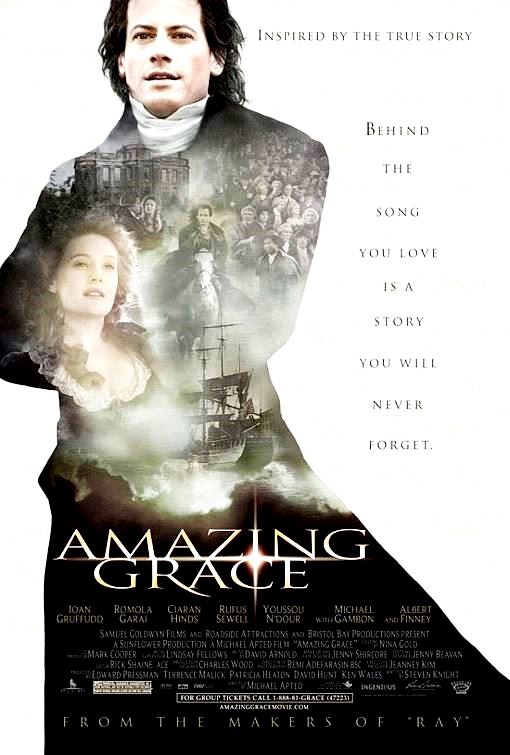

I had my pen and paper ready (thank you, David) and I have a list of films to look forward to. Many thanks!
Like everyone who sees this, I have something to add. I was surprised not to see the 2012 Lincoln – one of my all-time favorites. Daniel Day Lewis was born to play that role. I look forward to seeing what others have to add.